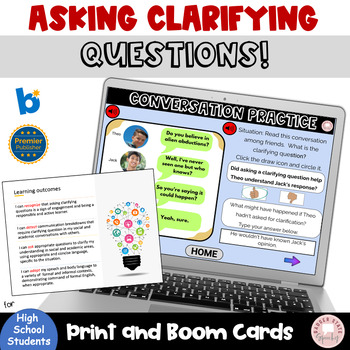Asking Clarification Questions for Social, Job and Academics
- PDF
- Internet Activities
Description
Complete lesson on asking clarification questions for older students. Content includes using clarification questions in social, academic and job (talking with work supervisors) - the practice scenarios lean towards being more appropriate for high schoolers. Learning outcomes given. Concepts & skills are taught. Vocabulary & knowledge checks, practice situations & review are built into this deck.
Includes:
- a student self rating (scale 1-10), & knowledge check (true/false).
Mini lessons on the following are provided:
- *definition & purpose of clarification questions,
- vocabulary and prior knowledge,
- *when to use them,
- *how questions may differ in informal/formal situations,
- *what clarification questions are NOT,
- *how to use them, & choosing the right question for the student's learning needs & context/situation,
- contrasts two types of learners (who do and don't ask questions),
- tone and body language, and
- review activities.
Skills: this deck incorporates activities for perspective taking and problem solving as students identify communication breakdowns & problems.
Vocabulary: definition, odd one out & use the word in a sentence.
Responses: T/F and multiple choice questions, drag & drop responses, drawing, recording and judging tone of voice, open-ended responses & practice scenarios for deeper dives into skills.
Learning Supports: help page, audio directions, scaffolded learning
Real photographs of middle school, high school & young adults are used, mutiple skin tones are represented. Audio directions. A scaffolded learning activity with learning supports & help page.
Accessibility: The BOOM cards are optimized for tab navigation & visually impaired users.
You might also like these products related to self-advocacy:
►When you download this product, you will receive a PDF with a link to the digital task cards on the Boom Learning Site. Click on the link. It will take you to the Boom learning site. YOU will need a boom account! Press redeem.
►The pdf contains the same content as the BOOM cards in a more pdf-friendly format. In addition, the pdf also contains an "asking clarification questions" diploma and a one-page mini poster.
More information on Boom Cards:
To use Boom Cards, you must be connected to the Internet. Boom Cards play on modern browsers (Chrome, Safari, Firefox, and Edge). Apps are available for Android, iPads, iPhones, and Kindle Fires. For security and privacy, adults must have a Boom Learning account to use and assign Boom Cards. You will be able to assign the Boom Cards you are buying with "Fast Pins," (play provides instant feedback for self-grading Boom Cards). Fast Play is always a free way for students to engage with Boom Cards decks. For additional assignment options you'll need a premium account. If you are new to Boom Learning, you will be offered a free trial of our premium account. Read here for details: http://bit.ly/BoomTrial
If you purchase, please leave feedback at my store and you will earn TPT credits towards future purchases at ANY TPT store!
ALL OF MY NEW PRODUCTS ARE HALF OFF FOR THE FIRST 48 HOURS. CLICK ON THE GREEN FOLLOW BUTTON TO BE NOTIFIED OF NEW PRODUCTS!
❤️ CONNECT on Facebook!
❤️ CONNECT on Instagram!





